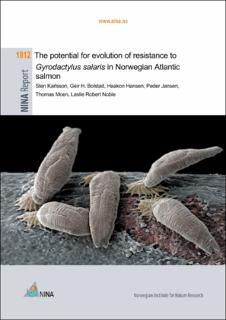| dc.contributor.author | Karlssen, Sten | |
| dc.contributor.author | Bolstad, Geir H. | |
| dc.contributor.author | Hansen, Haakon | |
| dc.contributor.author | Jansen, Peder | |
| dc.contributor.author | Moen, Thomas | |
| dc.contributor.author | Noble, Leslie Robert | |
| dc.date.accessioned | 2020-05-11T08:31:04Z | |
| dc.date.available | 2020-05-11T08:31:04Z | |
| dc.date.issued | 2020 | |
| dc.identifier.isbn | 978-82-426-4570-8 | |
| dc.identifier.issn | 1504-3312 | |
| dc.identifier.uri | https://hdl.handle.net/11250/2653791 | |
| dc.description.abstract | Karlsson, S., Bolstad, G.H., Hansen, H., Jansen, P.A., Moen, T. and Noble, L.R. 2020. The potential for evolution of resistance to Gyrodactylus salaris in Norwegian Atlantic salmon. NINA Report 1812. Norwegian Institute for Nature Research.
The ectoparasite, Gyrodactylus salaris, was introduced to Norway in the early 70’s, and has since then been found in 51 salmon rivers. Wherever the parasite has been introduced in Norway, the Atlantic salmon populations have been reduced to very low levels. The policy of management authorities is to eradicate the parasite. Gyrodactylus salaris has so far been confirmed eradicated from 38 rivers. In addition 5 rivers have been treated but have not yet been confirmed free from the parasite, and eight rivers have not yet been treated.
In this report we review relevant knowledge to evaluate the possibility for Atlantic salmon in Norway to naturally develop resistance or to develop resistance from selective breeding, and the possible consequences for the Atlantic salmon populations. Our main focus has been to give a summary of knowledge about the genetic basis for developing resistance, the most plausible time frame for such resistance to develop, the effects of migration, the probability of further spreading of the parasite and how this can affect genetic variation, and the genetic integrity and productivity of the salmon populations. We have also evaluated different strategies for breeding for resistance. As a basis for the evaluation of a possible resistance against G. salaris a large part of the report is devoted to a review of the general biology of the parasite (G. salaris) and the host (Atlantic salmon), and the evolutionary mechanisms behind host-parasite interactions.
We conclude that there is a genetic basis for developing resistance against G. salaris in Norwegian Atlantic salmon, but the timeframe to obtain a resistance to maintain viable populations would probably be on the order of hundreds of years or longer. A selective breeding program would probably speed up the process, but would require specific considerations for maintaining genetic integrity and genetic variation. Without supplementary stocking, G. salaris infected pop-ulations are not expected to reach a productivity at the level of the spawning target, and yield a harvestable surplus, until they have developed resistance against G. salaris. A strategy of developing resistance against G. salaris as opposed to eradicating the parasite will increase the risk of further spread of the parasite to additional rivers containing salmon that are susceptible to G. salaris. This would again lead to low natural productivity in consecutive infected stocks in the unforeseeable future. | en_US |
| dc.description.abstract | Karlsson, S., Bolstad, G., Hansen, H., Jansen, P.A., Moen, T. and Noble, L.R. 2020. Potensial for resistensutvikling mot Gyrodactylus salaris i norske villaksbestander. 2020. NINA Rapport 1812. Norsk institutt for naturforskning.
Gyrodactylus salaris ble introdusert tidlig på 70-tallet og har siden blitt påvist i totalt 51 villaksbestander. I samtlige bestander som parasitten blitt introdusert til har bestanden av villaks kollapset. Strategien til forvaltningsmyndighetene er å utrydde parasitten. Til nå har 38 elver blitt friskmeldt etter behandling, mens 5 elver er behandlet men ennå ikke friskmeldt. Åtte elver er ennå ikke behandlet.
Denne rapporten oppsummerer relevant kunnskap for å evaluere muligheten for norsk villaks å utvikle resistens mot G. salaris, enten naturlig eller ved avl, og hvilke mulige konsekvenser dette vil kunne ha for villaksbestandene. Hovedfokus har vært å gi en oppsummering av kunnskapen om det genetiske grunnlaget for resistensutvikling, det sannsynlige tidsperspektivet for resistensutvikling, effekten av migrasjon, sannsynligheten for videre spredning og hvordan dette kan påvirke genetisk variasjon, genetisk integritet og produktiviteten i laksebestandene, sett i forhold til ulike avlsstrategier for utvikling av resistens. Som grunnlag for evaluering av muligheten for resistensutvikling mot G. salaris består en stor del av rapporten av en kunnskapsoppsummering om den generelle biologien til G. salaris og verten (laksen), og de evolusjonære mekanismene bak en slik interaksjon mellom vert og parasitt.
Vi konkluderer med at det finnes en genetisk bakgrunn for utvikling av resistens mot G. salaris i norske villaksbestander, men at en utvikling av resistens på et nivå der bestandene er levedyktige vil sannsynligvis ta i størrelsesorden noen hundretalls år eller mer. Et seleksjonsprogram vil sannsynligvis kunne gi en raskere utvikling av resistens men vil være en utfordring for å ivareta genetisk variasjon og genetisk integritet for de forskjellige populasjonene. Så lenge infiserte bestander ikke er resistente mot parasitten forventes de ikke å kunne oppnå gytebestandsmålene og høstbare overskudd uten supplerende utsetting av fisk. En strategi ved å utvikle resistens mot G. salaris i stedet for å utrydde parasitten vil øke risikoen for videre spredning til andre vassdrag og dermed gi lav naturlig produksjon av laks i påfølgende infiserte vassdrag i uoverskuelig fremtid. | en_US |
| dc.language.iso | eng | en_US |
| dc.publisher | Norwegian Institute for Nature Research (NINA) | en_US |
| dc.relation.ispartofseries | NINA Report;1812 | |
| dc.subject | Gyrodactylus salaris | en_US |
| dc.subject | Atlantic salmon | en_US |
| dc.subject | Salmo salar | en_US |
| dc.subject | Resistance | en_US |
| dc.subject | Evolution | en_US |
| dc.subject | Alien species | en_US |
| dc.title | The potential for evolution of resistance to Gyrodactylus salaris in Norwegian Atlantic salmon | en_US |
| dc.type | Research report | en_US |
| dc.rights.holder | © Norwegian Institute for Nature Research
The publication may be freely cited where the source is acknowledged | en_US |
| dc.source.pagenumber | 64 | en_US |
| dc.relation.project | Miljødirektoratet: M-1697|2020 | en_US |
